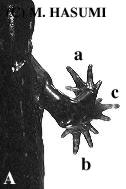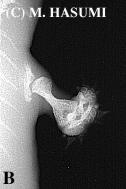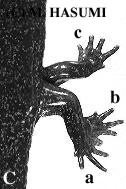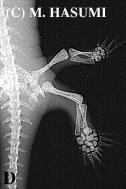



 |  |
 |  |
(A) A right forelimb of one specimen of Hynobius nigrescens (dorsal view). This forelimb is composed of three hands: a right hand (expressed by "a"), a symmetric left hand against the right hand ("b"), and a dwarfish hand ("c"). This dwarfish hand consists of three fingers.
(B) X-ray photograph of Fig. A.
(C) Two hindlimbs on the right side (multiple limbs, showing right-left symmetry) of one specimen of Hynobius lichenatus (dorsal view). A right hindlimb, located at a normal position, has a right foot (expressed by "a") and a symmetric left foot against the right foot ("b"). In these feet, the first toes are fused with each other. A symmetric hindlimb like a left one ("c") is branched from the base of the right hindlimb. A foot of this symmetric hindlimb includes a short third toe.
(D) X-ray photograph of Fig. C.
Amphibian deformities (e.g., polymelia) are believed to be derived either from developmental processes such as over-ripeness of ova, delayed fertilization, and extra regeneration from injury, or from environmental pollution such as heat shock on fertilized eggs, irradiation of X-ray or UV on fertilized eggs, and perhaps exposing fertilized eggs to chemical materials dissolved in the water for breeding.